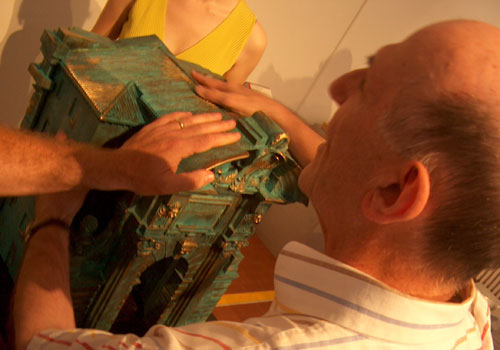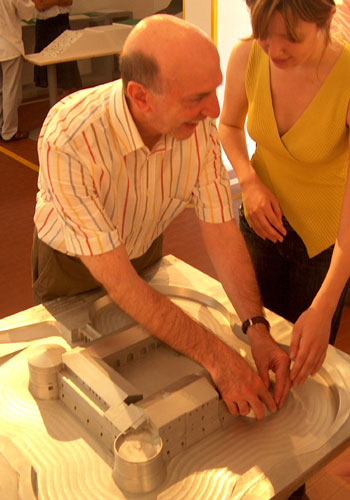Art within art: an exhibition of architectural models
Posted in Events on 24 June 2008

The great and small monument.
June to September 2008.
Museo Omero, Ancona.
The completion of the first phase of the Art within Art project was presented to a crowded and enthusiastic press conference on Tuesday 24th June 2008.
The project
"Art within art" is a project which aims to increase the scholastic and social integration of the partially-sighted through valid and significant art education as well as through access to, and enjoyment of, our artistic heritage, and architecture in particular.
Taking the school-territory link as a starting point, the project relaunches art as a factor in the integration of the visually handicapped. It began in 2005 with a formal agreement signed by the Ufficio Scolastico Regionale per le Marche, the Museo Tattile Statale Omero, the Unione Italiana dei Ciechi and the Università Politecnica delle Marche.
The Model Exhibition : June to September
The teachers and students from the Istituti Statali d'Arte of the Marches Region who took part the project created scale models of four important monuments situated in our region. These models will later be placed in their respective monuments.
The models are of: Porta Pia, Ancona, made of bronze by the ISA "Mannucci"; the Baptistry, Ascoli Piceno, made of plaster and powdered marble by the ISA "Licini"; the Rocca Costanza, Pesaro, made of alluminium by the ISA "Mengaroni"; decorative panels from the front and side portals of the Cathedral, Fermo, made of resin and terracotta by the ISA "Preziotti". The models will be on show all summer in the Architecture Section of the Museo Omero.
Thanks to the participation of the Istituti d'Arte, the students became more aware of the richness of their area and were able to engage with topics such as visual handicap and, in particular, approaching works of art through touch.
Comment: Aldo Grassini, Roberto Farroni, Andrea Socrati, Anna Maria Nardiello
"The results are excellent," declared Aldo Grassini, "not only from a scientific and tactile point of view, but also in artistic terms. These are artistic creations of a very high level. The orginal monument has acquired a piece of art of great beauty which will allow not only the blind and the partially-sighted but all visitors, to admire the complexity and the totality of the monument. As a matter of fact, visitors are rarely able to perceive the architecture of a church or old building as a whole".
Roberto Farroni, Museum Director, and Andrea Socrati, Special Project
Manager at our Learning Services, thanked the D.A.R.D.U.S. (Dipartimento Architettura Rilievo Disegno Urbanistica Storia) of the Università Politecnica delle Marche and, in particular, Professor Francesco Leoni, for providing documentation which was very useful for creating the models.
Professor Leoni, who was also present at the press conference, will be in charge of choosing the most significant and fruitful setting for each model within its monument.
Anna Maria Nardiello of the Ufficio Scolastico Provinciale confirmed their great interest and willingness to continue through the next phases which will definitely see the reinforcement and widening of the project outlines that have been so successfully put into practice.
The second phase
The second phase of the project, where the models will be placed in their own monuments, will start in September: a real experience of "art within art" which should encourage tactile exploration and not just among the partially-sighted. Everyone will be able to enjoy an unusual "duplication" of a local work of art inside its own monument as well as a multi-sensory stimulus promoted by a comprehensive vision of the work and the possibility of enjoying it through touch.
The non-sighted will therefore be able to explore the work in a natural context within the monument in the company of other visitors, rather than seeing it in in isolation in a separate, museum environment.
Expertise
The project has drawn on the experience of experts in the fields of: training and teaching; scientific aspects of the architecture sector;
teaching the partially-sighted; tactile education through artistic experience.
The Museo Tattile Statale Omero, with its years of experience in the field of tactile education, and the Unione Italiana Ciechi e degli Ipovedenti provided essential consultancy for the various phases of the project as did the Università Politecnica delle Marche, through the D.A.R.D.U.S. (Dipartimento Architettura Rilievo Disegno Urbanistica Storia). The Ufficio Scolastico Regionale provided the finance for the Istituti d¹Arte delle Regione Marche that created the models.
The future of the project
It is planned to produce a DVD documenting the various phases of the project. This will be an important contribution to the culture of tactile
education as well as an account of an innovative way of learning about the history and artistic heritage of the Marches. Being an easily reproducible medium, it will be readily available.
This project is unique in Italy and should be considered as a pilot project carried out in our region. The Ministero dell'Istruzione, dell'Università e della Ricerca will be examining the possibility of extending this experiment throughout Italy, in particular, the scale model aspect and the teacher training aspect through the creation of on-line training systems, with the prospect of using an integrated e-learning environment.
More images

